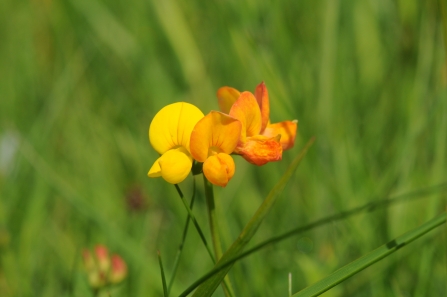
Tops tips for creating a wildlife lawn:
- Less mowing
By leaving parts of your lawn unmown you can create a busy wildlife habitat. Plants such as clover, daisies and buttercups will have the chance to grow and bloom, and their pollen will attract pollinating bees and butterflies. Longer grasses can also provide shelter and places to forage for animals such as frogs and hedgehogs.
- Is it a weed?
Some wildflowers such as bird's-foot trefoil, lesser celandine and selfheal are traditionally thought of as weeds, but they are very beneficial for pollinators as well as being the foodplants for caterpillars of butterflies species such as common blues and green hairstreaks.
- Avoid weed killers and pesticides
Weed killers remove plants that could attract bees and other pollinating insects. Where possible remove weeds like thistles, nettles and dock by the root.
Rather than pesticides, use alternative treatments to control problematic species. For example, spray water with washing-up liquid on plants with aphids and use serrated copper tape around plants to discourage slugs and snails.
- Add variety to your grass
Most gardens only have a few grass species, but grasses are a diverse group and diversity can add a variety of structure and colour to your garden. If they are left unmown, they will produce flowers and seeds which are important for many animals.
- Turn your lawn into a wildflower meadow
To get a more diverse range of flowers you could add some plants yourself. Many places sell wildflower mixes, but try to stick to native seeds such as: common knapweed, red clover, kidney vetch, yarrow, devil's bit scabious, ox-eye daisy, field scabious, teasel, cowslip, selfheal, betony and meadow buttercup.
- Don't use fertiliser
Although well fertilised soils support thick grass growth, this is to the detriment of wildflowers, so to increase diversity in your lawn, don't add fertiliser, manure or compost.
- When to cut a wildflower lawn
In the first year of establishing a mini meadow cut it to approximately 7cm every 6-8 weeks to keep vigorous species under control and encourage good root development. In future years, mow until early April but then leave it until late in the flowering season to give the wildflowers the chance to set seed. After mowing leave the clippings for a few days to let any seeds fall.

